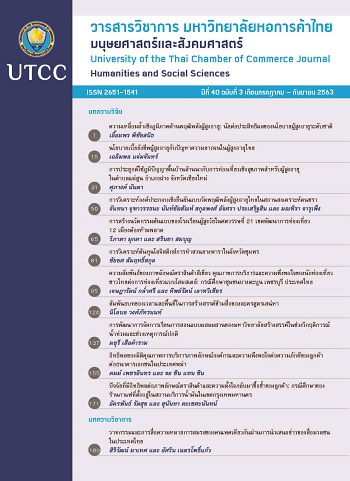วาทกรรมและการสื่อความหมายการสมรสของคนเพศเดียวกัน ผ่านการนำเสนอข่าวของสื่อมวลชนในประเทศไทย
Main Article Content
บทคัดย่อ
การเกิดขึ้นในความสัมพันธ์ทางเพศของมนุษย์ และการดำรงชีวิตคู่ของมนุษย์ในสังคมหนึ่งๆ นั้น เป็นไปในหลายรูปแบบ ทั้งความสัมพันธ์ที่เกิดขึ้นด้วยชายกับหญิง ชายกับชาย และหญิงกับหญิง หรือมีความสัมพันธ์ที่ซับซ้อนเกิดขึ้นในทุกยุคทุกสมัย บทความวิชาการนี้มีวัตถุประสงค์มุ่งศึกษาว่าสื่อมวลชนในประเทศไทยให้ความหมายการสมรสของคนเพศเดียวกันที่ถูกนำเสนอผ่านข่าวไว้ว่าอย่างไร และกระบวนการทางวาทกรรมการสมรสของคนเพศเดียวกันในสังคมไทยที่ถูกกำหนดจากสถาบันทางสังคมมีลักษณะอย่างไร โดยผู้เขียนได้ใช้แนวทางด้านวัฒนธรรมศึกษา (cultural studies) มาเป็นแกนหลักเพื่อเชื่อมโยงความสัมพันธ์การใช้ชีวิตคู่ของสังคมมนุษย์ที่เป็นเพศเดียวกันกับการนำเสนอข่าวของสื่อมวลชนในประเทศไทยในช่วง พ.ศ. 2556–2561 ซึ่งการกำหนดความหมายการสมรสของคนเพศเดียวกันที่ยังคงผูกโยงอยู่กับบริบททางสังคม การให้คุณค่าทางค่านิยมของวัฒนธรรม จารีตประเพณี ตลอดจนสถาบันต่างๆ ทางสังคมที่แวดล้อมเคียงคู่อยู่กับสังคมไทย กล่าวได้ว่าต่างก็เป็นปัจจัยส่งผลให้เกิดข้อคำถามถึงความเหมาะสม และความเป็นไปได้อย่างไรบ้างที่คนเพศเดียวกันจะจัดพิธีกรรมการแต่งงานในโครงสร้างสังคมแบบเศรษฐกิจทุนนิยม ทั้งนี้ เมื่อคู่รักเพศเดียวกันได้เข้ามาต่อสู้ช่วงชิงความหมายหรือความชอบธรรมในสนามรบของการสมรสนั้น สามารถพบข้อสังเกตใน 2 ด้าน กล่าวคือ 1) ความพยายามของโครงสร้างทางสังคมในการธำรงรักษาความชอบธรรมแบบเดิมไว้ในพื้นที่ของคู่รักระหว่างเพศ (heterosexuality) 2) อีกด้านหนึ่ง คือ ปัจเจก บุคคล (คู่รักเพศเดียวกัน) ซึ่งเป็นกลุ่มใหม่ของสังคมที่พยายามเข้ามาต่อรองช่วงชิงความชอบธรรมในพื้นที่นี้ โดยเป็นการปะทะกันระหว่างสองด้านในสนามรบที่เป็นเรื่องของคำและการกำหนดความหมายในพื้นที่ของสื่อมวลชนด้วย ซึ่งเบื้องหลังของวัฒนธรรมทางสถาบันต่างๆ เหล่านี้ได้แสดงบทบาททางอำนาจด้วยการสร้างชุดความคิดใดความคิดหนึ่งที่เข้ามากำหนดเกี่ยวกับความสัมพันธ์การใช้ชีวิตคู่ของสังคมมนุษย์อยู่เสมอ
Article Details
ลิขสิทธิ์ของบทความ
ผลงานที่ได้รับการตีพิมพ์ถือเป็นลิขสิทธิ์ของมหาวิทยาลัยหอการค้าไทย ห้ามมิให้นำเนื้อหา ทัศนะ หรือข้อคิดเห็นใด ๆ ของผลงานไปทำซ้ำ ดัดแปลง หรือเผยแพร่ ไม่ว่าทั้งหมดหรือบางส่วนโดยไม่ได้รับอนุญาตเป็นลายลักษณ์อักษรจากมหาวิทยาลัยหอการค้าไทยก่อน
เอกสารอ้างอิง
กรมศิลปากร. (2515). ประเพณีเกี่ยวกับชีวิต. กรุงเทพฯ: โรงพิมพ์สามมิตร.
กฤตยา อาชวนิจกุล. (2554). เพศวิถีที่กำลังเปลี่ยนแปลงไปในสังคมไทย. วารสารประชากรและสังคม,15(1), 43–65.
กาญจนา แก้วเทพ. (2543). สื่อสารมวลชน: ทฤษฎีและแนวทางการศึกษา. กรุงเทพฯ: เอดิสันเพรสโปรดักส์.
กาญจนา แก้วเทพ, และสมสุข หินวิมาน. (2551). สายธารแห่งนักคิดทฤษฎีเศรษฐศาสตร์การเมือง กับสื่อสารศึกษา. กรุงเทพฯ: ภาพพิมพ์.
กำจร หลุยยะพงศ์, และสมสุข หินวิมาน. (2551). ภาพยนตร์ไทยในรอบสามทศวรรษ (พ.ศ. 2520-2547): กรณีศึกษาตระกูลหนังผี หนังรัก และหนังยุคหลังสมัยใหม่. กรุงเทพฯ: สำนักงานกองทุนสนับสนุนการวิจัย.
กิตติกร สันคติประภา. (2550). การลวนลามทางเพศกะเทย: นัยสำคัญภายใต้วาทกรรมรักต่างเพศ(วิทยานิพนธ์ปริญญาดุษฎีบัณฑิต ไม่ได้ตีพิมพ์). มหาวิทยาลัยศรีนครินทรวิโรฒ, กรุงเทพฯ.
กุหลาบ สายประดิษฐ์. (2524). กำเนิดครอบครัวของมนุษยชาติ ระเบียบสังคมมนุษย์. กรุงเทพฯ:กอไผ่.
ณรงค์กร มโนจันทร์เพ็ญ. (2561). จะยกธงเขียวหรือธงขาว? สิทธิสมรสของคู่รักเพศเดียวกันในสังคมโลกและสังคมไทย ปี 2018/2019. สืบค้นเมื่อ 22 ธันวาคม 2562, จาก https://thestandard.co/lgbt-rights-same-sex-marriage-laws-2018-2019/
นฤพนธ์ ด้วงวิเศษ. (2015). ทบทวนวิธีการสร้างความรู้ ความจริงเรื่องเพศ. กรุงเทพฯ: ศูนย์มานุษยวิทยาสิรินธร.
บารมี พานิช. (2559). รูปแบบและขั้นตอนการขับเคลื่อนร่างพระราชบัญญัติการจดทะเบียนคู่ชีวิตในประเทศไทย (วิทยานิพนธ์ปริญญามหาบัณฑิต ไม่ได้ตีพิมพ์). สถาบันบัณฑิตพัฒนบริหารศาสตร์, กรุงเทพฯ.
บุษกร สุริยสาร. (2557). อัตลักษณ์และวิถีทางเพศในประเทศไทย. กรุงเทพฯ: องค์การแรงงานระหว่างประเทศ.
ปิยลักษณ์ โพธิวรรณ์. (2545). คนข้ามเพศ: ตัวตน วัฒนธรรมย่อย และพื้นที่ทางสังคม. วารสารดำรงวิชาการ, 10(1), 98-125.
พิมลพรรณ อิศรภักดี. (2558). ต่างวัยต่างทัศนะต่อความหลากหลายทางเพศในสังคมไทยความหลากหลายทางประชากรและสังคมในประเทศไทย. กรุงเทพฯ: มหาวิทยาลัยมหิดล, สถาบันวิจัยประชากรและสังคม.
เสถียรโกเศศ. (2501). ประเพณีเรื่องแต่งงานบ่าวสาวของไทย. กรุงเทพฯ: โรงพิมพ์รุ่งเรืองธรรม.
อัตนันท์ เตโชพิศาลวงศ์. (2554). วาทกรรมสะท้อนภาพไทยผ่านหนังสือพิมพ์ประเทศอนุภูมิภาค
ลุ่มน้ำโขง (วิทยานิพนธ์ปริญญาดุษฎีบัณฑิต ไม่ได้ตีพิมพ์). มหาวิทยาลัยธรรมศาสตร์, กรุงเทพฯ.
อัศวิน เนตรโพธิ์แก้ว. (2555). การสื่อสารผ่านสื่อใหม่ในยุคสังคมสารสนเทศ. วารสารอิศราปริทัศน์,1(2), 80–91.
อานันท์ กาญจนพันธุ์. (2555). คิดอย่างมิเชล ฟูโกต์ คิดอย่างวิพากษ์จากวาทกรรมของอัตบุคคลถึง จุดเปลี่ยนของอัตตา. เชียงใหม่: มหาวิทยาลัยเชียงใหม่.
ฮือฮาชายแต่งชาย จนท.พิพิธภัณฑ์-เจ้าของร้านเช่าชุดนาฏศิลป์ นายกเล็กอุดรฯ ประธานจัดงาน.(2557, 3 สิงหาคม). ข่าวสดออนไลน์. สืบค้นจาก https://www.khaosod.co.th/ view_newsonline phpnewsid=TVRRd056QTBNREEyTWc9PQ%3D%3D§ionid
ฮือฮาตร.นะยะ แต่งผัวล่ำบึ้ก จัดคอนเสิร์ตฉลองวิวาห์. (2560, 5 พฤษภาคม). ไทยรัฐออนไลน์. สืบค้นจาก https://www.thairath.co.th/content/932002
ฮือฮาสาวหล่อแต่งสาวสวย รัก 3 ปี สินสอดเงิน 3 แสน. (2558, 20 กุมภาพันธ์). ไทยรัฐออนไลน์. สืบค้นจาก https://www.thairath.co.th/content/482394
Foucault, M. (1972). The Archeology of Knowledge (and The Discourse on Language). New York: Pantheon Books.
Jackson, P. A. (1999). Tolerant but unaccepting: The myth of a Thai “gay paradise.” In P. A.
Jackson & N. M. Cook (Eds.), Genders and sexualities in modern Thailand (pp. 226–242). Chiang Mai, Thailand: Silkworm Books.
Wang, Z. (2017). Eyeing marriage equality: News media representation of same-sex marriage legalization debate in Taiwan (Unplublished master’s thesis). Lund University, Sweden.


